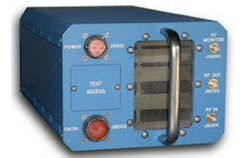Mercury announced a Navy order for advanced Digital RF Memory (DRFM) jammers. Mercury Defense Systems, formerly KOR Electronics, won a $1.5 million Navy order last June for the Mercury Airborne 1225 advanced DRFM electronic warfare (EW) jammers.
The order is part of a contract worth as much as $56.7 million, Mercury officials say. KOR Electronics (now Mercury Defense Systems) originally won the contract to develop the DRFM in March 2010. The award increased in 2013.
Related: Mercury to provide Navy with advanced airborne electronic warfare jamming training devices
The Mercury Airborne 1225 ruggedized air-cooled, airborne 3-bit miniaturized digital RF memory (DRFM) was developed for airborne, pod, and unmanned aerial vehicle (UAV) applications with as much bandwidth as 1200 MHz. It is self-contained with internal techniques and RF and power supplies.
More than 130 units have been produced for several users. The UAV radar suite controller (RCS) enhancement and deceptive electronic countermeasures (ECM) are its primary applications.
DRFM technology has several features. First, it provides coherent time delay of RF signals in applications like radar and electronic warfare. It also produces coherent deception jamming to a radar system by replaying a captured radar pulse with a small delay, which makes the target appear to move.
DRFM also can modulate captured pulse data in amplitude, frequency, and phase to provide other affects. A Doppler shift correlates range and range rate trackers in the radar. DRFM also can replay captured radar pulses many times to fool the radar into perceiving many targets.
Small packages, fast response, and large volumes of low-latency compute power define modern DRFM evolution, Mercury officials say. The company's latest DRFM technology produces modules as thin as 0.44 inches, and capitalizes on direct digital synthesizer (DDS) local oscillator (LO) technology.
DDS delivers sub-microsecond tuning speeds over a wide bandwidth, while advanced circuit design and simulation helps reduce spurious, inter-module and phase noise.
Related: Webcast covers digital signal processing for signals intelligence and electronic warfare
The Mercury 1225 DRFM has more than 15 dBc worst-case spurious suppression across the entire band with typical spurs of more than 19 dBc. The Airborne 1225 has storage for as many as 48 user-defined deception programs.
"The continued technology advancements are designed to keep pace with the evolving threats and ensure U.S. aircrews are being properly trained prior to engagements in combat environments," says Brian Perry, president of Mercury Defense Systems.
Electronic countermeasures techniques for pipeline, stretched pulse including synthetic continuous wave, and multiple false target modes are defined through the device's user interface.
The unit has one RF converter, one converter/memory, and one system controller; three bit phase encoding at 1.2 GHz instantaneous bandwidth; can program each false target for range, Doppler, and bi-phase; can track as many as four emitters; and offers internal techniques against two to four emitters. Mercury engineers should complete and ship the latest DRFM order by 2016.
For more information contact Mercury Defense Systems online at www.mrcy.com/defense_systems.



